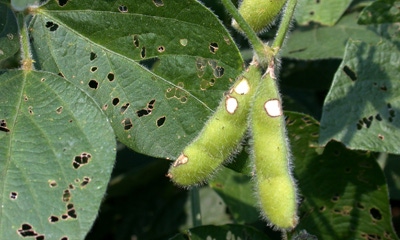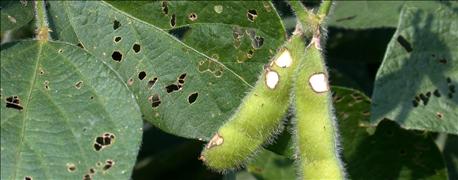
Should you still be scouting for insects in soybeans this late in the season? Is it worth your time and effort in terms of protecting yield? If so, which insects should you scout for?
The Indiana Certified Crop Adviser panel answers these questions. The panel includes Betsy Smith, agronomist, Ceres Solutions, Terre Haute; Dan Ritter, agronomist, Brodbeck Seeds, Rensselaer; and Brian Shrader, accounts manager, DuPont Pioneer, Marion.
Here are seven insects these experts watch for during the latter part of the growing season.
1. bean leaf beetles

UGLY SIGHT: Agronomists say it’s better to scout and know bean leaf beetle feeding is out there than to pretend it’s not! (All photos courtesy of John Obermeyer, Purdue University entomologist)
Bean leaf beetles are around early in the season, but another generation of this pest can return to fields now. Bean leaf beetles can open up pods, making it easier for other organisms to invade and affect seed quality, Smith notes.
“Treat if you find 8% to 12% feeding on pods and over four beetles per sweep in 20 sweeps with a sweep net,” Smith suggests.
Shrader adds that your first tipoff to bean leaf beetle feeding may be observing holes or tears in leaves (see photo at left). You may also find scarring on pods from past feeding, even if the pod isn’t completely opened.
2. stinkbugs

Bean leaf beetles aren’t the only insect that can damage developing pods. Stinkbugs (see photo at right) can damage soybean seeds themselves inside the pods, Smith notes. Therefore, the threshold for treatment is lower than for bean leaf beetles.
“Control if you find at least four or more nymphs or beetles in sets of 10 sweeps in five areas of the field,” Smith says.
Using a sweep net means you’re into serious scouting. Remember, the purpose is to avoid serious yield damage, so serious scouting is worth it, the CCAs believe.

3. soybean aphids
“Soybean aphid is the first insect that comes to my mind,” Ritter says. “Treatment under certain circumstances can improve yields.”
Shrader notes that aphids are typically found on the underside of soybean leaves and on stems. Look for a sticky "honeydew" substance that develops where they feed.
4. soybean cyst nematode

OK, technically this is not an insect, but Smith discusses SCN whenever she talks about soybean insects because of the potential damage nematodes can do where numbers are high in the soil.
“Look for soybeans that may be maturing early in spots,” she says. “Variable maturity could be an indication that a field has high levels of cyst nematodes. A simple soybean root and/or soil test sent to the Purdue University nematology lab would let you know presence or absence of SCN. That can help you plan for next year."
Note the cysts on the roots in the photo.

5. Japanese beetles
Shrader puts Japanese beetles on his list. Most of their damage may be done at this point. However, signs of feeding may still remain.
Again, look for holes or tearing of leaves. Japanese beetles tend to leave larger holes, typically on upper leaves at the time when they’re feeding.
6. and 7. grasshoppers and green cloverworms
Grasshoppers and green cloverworms can do quite a bit of foliar feeding, Ritter says. At this time of year, it takes a lot of foliar feeding damage to impact yield and warrant treatment. However, grasshoppers (below left) and green cloverworms (below right) can still feed on pods, so both deserve watching, he says.


About the Author(s)
You May Also Like




